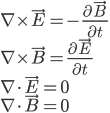Is it possible to influence the light with an electric field?
It turns out you can. And below I will tell you how. This post was born from my answer to a question posed on the Quora website.

It will be a quantum vacuum. So he looks in the artist's view.
Credit: lactamme.polytechnique.fr
The question in the original is:
Or translated:
Generally speaking, and this is indicated in the answers to Quora, the question is not entirely correctly formulated. Light is not a particle, but a wave or (particle-wave dualism!) Stream of particles, quanta of light - photons. However, this incorrectness does not cancel the question itself. Indeed, if light is of an electromagnetic nature, then why not influence it with electromagnetic fields?

This is approximately how an electromagnetic wave is usually depicted in training courses.
Why I wanted to answer this question is because it, in fact, has a double bottom. There is an obvious answer and an answer that can be given only with certain knowledge that goes beyond the school curriculum.
But first, we agree that the discussion will only be about vacuum, since the propagation of light in a medium can be influenced by an electric or magnetic field indirectly through exposure to this medium.
So, the obvious answer is: no, you can’t. Why not, it can be explained in different ways depending on how you represent the light.
If light is described as an electromagnetic wave, the impossibility of influencing it by electromagnetic fields follows from the linearity of Maxwell's equations, which actually describe all electromagnetic phenomena in classical physics. An electromagnetic wave is one of the solutions to these equations, and an external field is another solution. Due to the linearity property, their sum is also a solution of Maxwell's equations, and therefore they do not “interfere” with each other and do not have any effect on each other.

Maxwell's equations in vacuum in the SI system
If we describe light as a stream of particles - photons - then the answer is explained by the fact that photons do not have an electric charge, and electromagnetic fields act only on charged particles. Interestingly, this situation is unique to electromagnetic interaction. The carriers of the other two fundamental interactions, weak and strong, can themselves also take part in the interaction they carry.

Who interacts with whom in the Standard Model.
Credit: Trush Vitaliy // Wikimedia Commons // CC-BY-SA 3.0
For example, according to quantum chromodynamics, a strong interaction is carried by gluons. They interact between particles with a so-called color charge - an analogue of an electric charge for strong interaction. In this case, gluons themselves have a color charge and therefore interact with each other and with other particles with a color charge.
Let us return, however, to oursheep photons.
I already noted above that the obvious answer is only the first layer. Let's remove the second one. So, the non-obvious answer is yes, you can influence the light with external fields.
This possibility is due to the fact that, according to quantum electrodynamics, vacuum, also called quantum vacuum, is not an absolute void. Moreover, it is filled with so-called virtual particles, also known as quantum fluctuations. They can be thought of as being born for a short period of time and then annihilating pairs of particles and antiparticles, primarily the electron and positron.

A picture explaining the idea of quantum fluctuations.
Credit: universe-review.ca
If we continue to describe quantum vacuum in the form of images, then in an external electric (and magnetic, but dwell only on an electric) field, virtual pairs begin to live a little longer, since the electric force slightly “pulls them apart”. This leads to the fact that the vacuum appears polarization. And where there is polarization, there is also a dielectric constant!
If you remember the school course in optics, then further considerations should be obvious to you. Indeed, we know that a change in dielectric constant leads to a change in the refractive index and speed of light, and this, in turn, leads to refraction and reflection of light.
This effect, of course, is very weak, and its observation requires absolutely fantastic fields. In addition, it would be very difficult to observe the refraction of light in such fields because of its insignificance. Despite this, they are now seriously talking about observing in 10–20 years the effect of vacuum polarization on the propagation of light in the laboratory.
In this case, it is proposed to use ultra-high peak power lasers to generate superstrong fields. At the moment, lasers with a power of more than 1 petawatt have been built (peta means a factor of 10 15 ), with their help radiation was obtained, the electric field in which reaches a value of the order of 10 14 –10 15volt per meter. This is only 1000 times less than the so-called Schwinger limit, at which the effects of quantum electrodynamics in vacuum become noticeable.
However, to observe the effect it is not necessary to reach the limit; enough fields are tens of times weaker. And this means that after just one or two generations of heavy-duty lasers - at powers of about 100 petawatts - the laboratory will be able to change the direction of light propagation using another light, that is, using electromagnetic fields. In this case, however, they will measure not the direction of propagation, but the polarization of light. The fact is that vacuum in a superstrong field acts as a birefringent medium . The velocities of waves with different polarizations in such a medium are different, therefore, when an arbitrarily polarized wave propagates in it,its polarization will change and this change is much easier to measure.

It will be a quantum vacuum. So he looks in the artist's view.
Credit: lactamme.polytechnique.fr
Where does the question come from?
The question in the original is:
Light is an electromagnetic particle. Can we deviate its path by applying electric or magnetic fields to it?
Or translated:
Light is an electromagnetic particle. Can we change its trajectory by applying an electric or magnetic field?
Generally speaking, and this is indicated in the answers to Quora, the question is not entirely correctly formulated. Light is not a particle, but a wave or (particle-wave dualism!) Stream of particles, quanta of light - photons. However, this incorrectness does not cancel the question itself. Indeed, if light is of an electromagnetic nature, then why not influence it with electromagnetic fields?

This is approximately how an electromagnetic wave is usually depicted in training courses.
Why I wanted to answer this question is because it, in fact, has a double bottom. There is an obvious answer and an answer that can be given only with certain knowledge that goes beyond the school curriculum.
But first, we agree that the discussion will only be about vacuum, since the propagation of light in a medium can be influenced by an electric or magnetic field indirectly through exposure to this medium.
Obvious answer
So, the obvious answer is: no, you can’t. Why not, it can be explained in different ways depending on how you represent the light.
If light is described as an electromagnetic wave, the impossibility of influencing it by electromagnetic fields follows from the linearity of Maxwell's equations, which actually describe all electromagnetic phenomena in classical physics. An electromagnetic wave is one of the solutions to these equations, and an external field is another solution. Due to the linearity property, their sum is also a solution of Maxwell's equations, and therefore they do not “interfere” with each other and do not have any effect on each other.

Maxwell's equations in vacuum in the SI system
If we describe light as a stream of particles - photons - then the answer is explained by the fact that photons do not have an electric charge, and electromagnetic fields act only on charged particles. Interestingly, this situation is unique to electromagnetic interaction. The carriers of the other two fundamental interactions, weak and strong, can themselves also take part in the interaction they carry.

Who interacts with whom in the Standard Model.
Credit: Trush Vitaliy // Wikimedia Commons // CC-BY-SA 3.0
For example, according to quantum chromodynamics, a strong interaction is carried by gluons. They interact between particles with a so-called color charge - an analogue of an electric charge for strong interaction. In this case, gluons themselves have a color charge and therefore interact with each other and with other particles with a color charge.
Let us return, however, to our
Unobvious answer
I already noted above that the obvious answer is only the first layer. Let's remove the second one. So, the non-obvious answer is yes, you can influence the light with external fields.
This possibility is due to the fact that, according to quantum electrodynamics, vacuum, also called quantum vacuum, is not an absolute void. Moreover, it is filled with so-called virtual particles, also known as quantum fluctuations. They can be thought of as being born for a short period of time and then annihilating pairs of particles and antiparticles, primarily the electron and positron.

A picture explaining the idea of quantum fluctuations.
Credit: universe-review.ca
If we continue to describe quantum vacuum in the form of images, then in an external electric (and magnetic, but dwell only on an electric) field, virtual pairs begin to live a little longer, since the electric force slightly “pulls them apart”. This leads to the fact that the vacuum appears polarization. And where there is polarization, there is also a dielectric constant!
If you remember the school course in optics, then further considerations should be obvious to you. Indeed, we know that a change in dielectric constant leads to a change in the refractive index and speed of light, and this, in turn, leads to refraction and reflection of light.
This effect, of course, is very weak, and its observation requires absolutely fantastic fields. In addition, it would be very difficult to observe the refraction of light in such fields because of its insignificance. Despite this, they are now seriously talking about observing in 10–20 years the effect of vacuum polarization on the propagation of light in the laboratory.
In this case, it is proposed to use ultra-high peak power lasers to generate superstrong fields. At the moment, lasers with a power of more than 1 petawatt have been built (peta means a factor of 10 15 ), with their help radiation was obtained, the electric field in which reaches a value of the order of 10 14 –10 15volt per meter. This is only 1000 times less than the so-called Schwinger limit, at which the effects of quantum electrodynamics in vacuum become noticeable.
However, to observe the effect it is not necessary to reach the limit; enough fields are tens of times weaker. And this means that after just one or two generations of heavy-duty lasers - at powers of about 100 petawatts - the laboratory will be able to change the direction of light propagation using another light, that is, using electromagnetic fields. In this case, however, they will measure not the direction of propagation, but the polarization of light. The fact is that vacuum in a superstrong field acts as a birefringent medium . The velocities of waves with different polarizations in such a medium are different, therefore, when an arbitrarily polarized wave propagates in it,its polarization will change and this change is much easier to measure.
